BIS0010 Assessment 1 Template
VerifiedAdded on 2022/11/28
|13
|5177
|191
AI Summary
This document provides a template for BIS0010 Assessment 1, which includes exercises on literature search, review notes, and marking. It guides students on conducting effective literature searches, highlighting errors in literature review notes, and evaluating the use of evidence in literature reviews. The document also provides examples of relevant sources and common errors to avoid. The assessment criteria table helps students understand how their work will be evaluated.
Contribute Materials
Your contribution can guide someone’s learning journey. Share your
documents today.
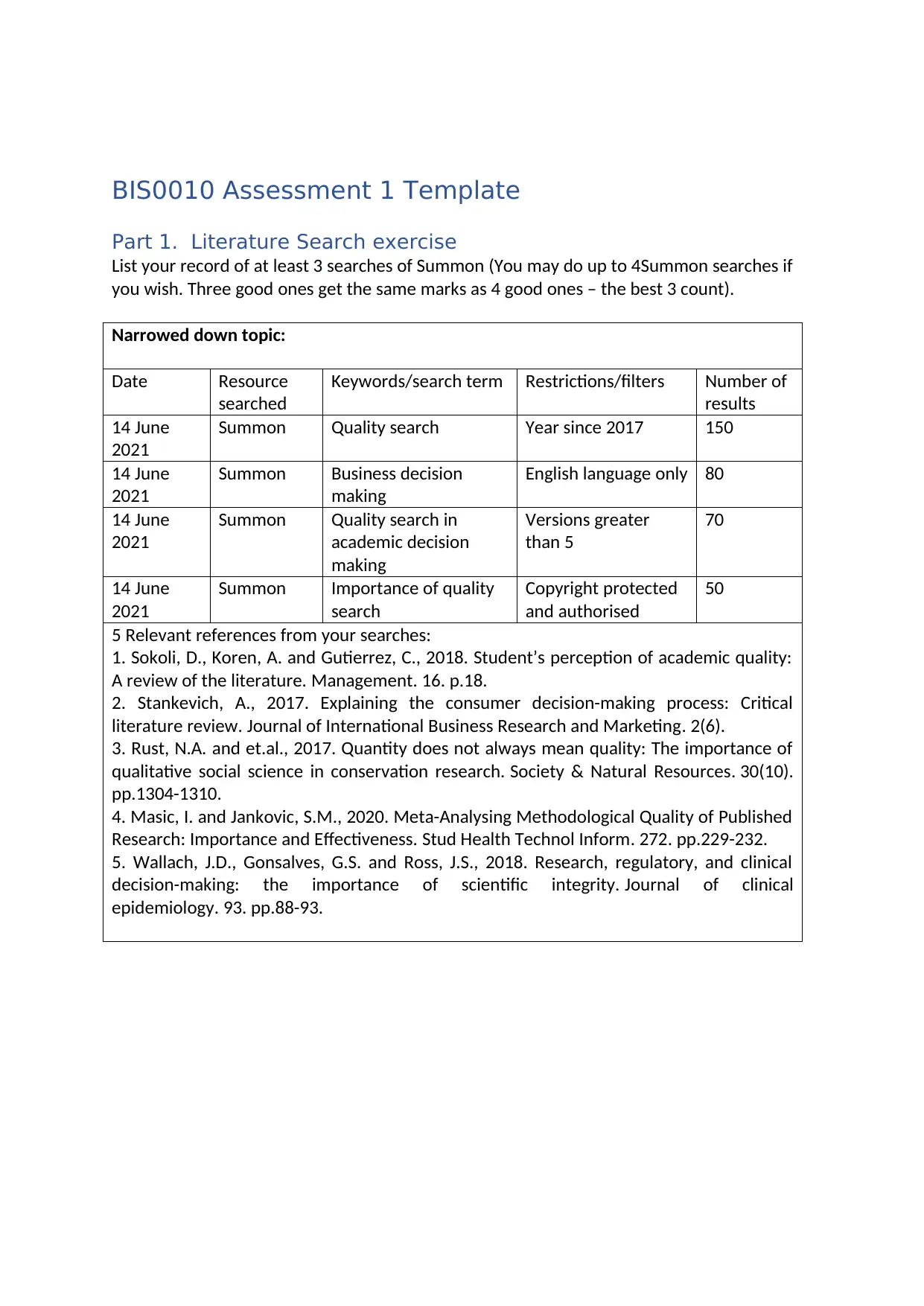
BIS0010 Assessment 1 Template
Part 1. Literature Search exercise
List your record of at least 3 searches of Summon (You may do up to 4Summon searches if
you wish. Three good ones get the same marks as 4 good ones – the best 3 count).
Narrowed down topic:
Date Resource
searched
Keywords/search term Restrictions/filters Number of
results
14 June
2021
Summon Quality search Year since 2017 150
14 June
2021
Summon Business decision
making
English language only 80
14 June
2021
Summon Quality search in
academic decision
making
Versions greater
than 5
70
14 June
2021
Summon Importance of quality
search
Copyright protected
and authorised
50
5 Relevant references from your searches:
1. Sokoli, D., Koren, A. and Gutierrez, C., 2018. Student’s perception of academic quality:
A review of the literature. Management. 16. p.18.
2. Stankevich, A., 2017. Explaining the consumer decision-making process: Critical
literature review. Journal of International Business Research and Marketing. 2(6).
3. Rust, N.A. and et.al., 2017. Quantity does not always mean quality: The importance of
qualitative social science in conservation research. Society & Natural Resources. 30(10).
pp.1304-1310.
4. Masic, I. and Jankovic, S.M., 2020. Meta-Analysing Methodological Quality of Published
Research: Importance and Effectiveness. Stud Health Technol Inform. 272. pp.229-232.
5. Wallach, J.D., Gonsalves, G.S. and Ross, J.S., 2018. Research, regulatory, and clinical
decision-making: the importance of scientific integrity. Journal of clinical
epidemiology. 93. pp.88-93.
Part 1. Literature Search exercise
List your record of at least 3 searches of Summon (You may do up to 4Summon searches if
you wish. Three good ones get the same marks as 4 good ones – the best 3 count).
Narrowed down topic:
Date Resource
searched
Keywords/search term Restrictions/filters Number of
results
14 June
2021
Summon Quality search Year since 2017 150
14 June
2021
Summon Business decision
making
English language only 80
14 June
2021
Summon Quality search in
academic decision
making
Versions greater
than 5
70
14 June
2021
Summon Importance of quality
search
Copyright protected
and authorised
50
5 Relevant references from your searches:
1. Sokoli, D., Koren, A. and Gutierrez, C., 2018. Student’s perception of academic quality:
A review of the literature. Management. 16. p.18.
2. Stankevich, A., 2017. Explaining the consumer decision-making process: Critical
literature review. Journal of International Business Research and Marketing. 2(6).
3. Rust, N.A. and et.al., 2017. Quantity does not always mean quality: The importance of
qualitative social science in conservation research. Society & Natural Resources. 30(10).
pp.1304-1310.
4. Masic, I. and Jankovic, S.M., 2020. Meta-Analysing Methodological Quality of Published
Research: Importance and Effectiveness. Stud Health Technol Inform. 272. pp.229-232.
5. Wallach, J.D., Gonsalves, G.S. and Ross, J.S., 2018. Research, regulatory, and clinical
decision-making: the importance of scientific integrity. Journal of clinical
epidemiology. 93. pp.88-93.
Secure Best Marks with AI Grader
Need help grading? Try our AI Grader for instant feedback on your assignments.
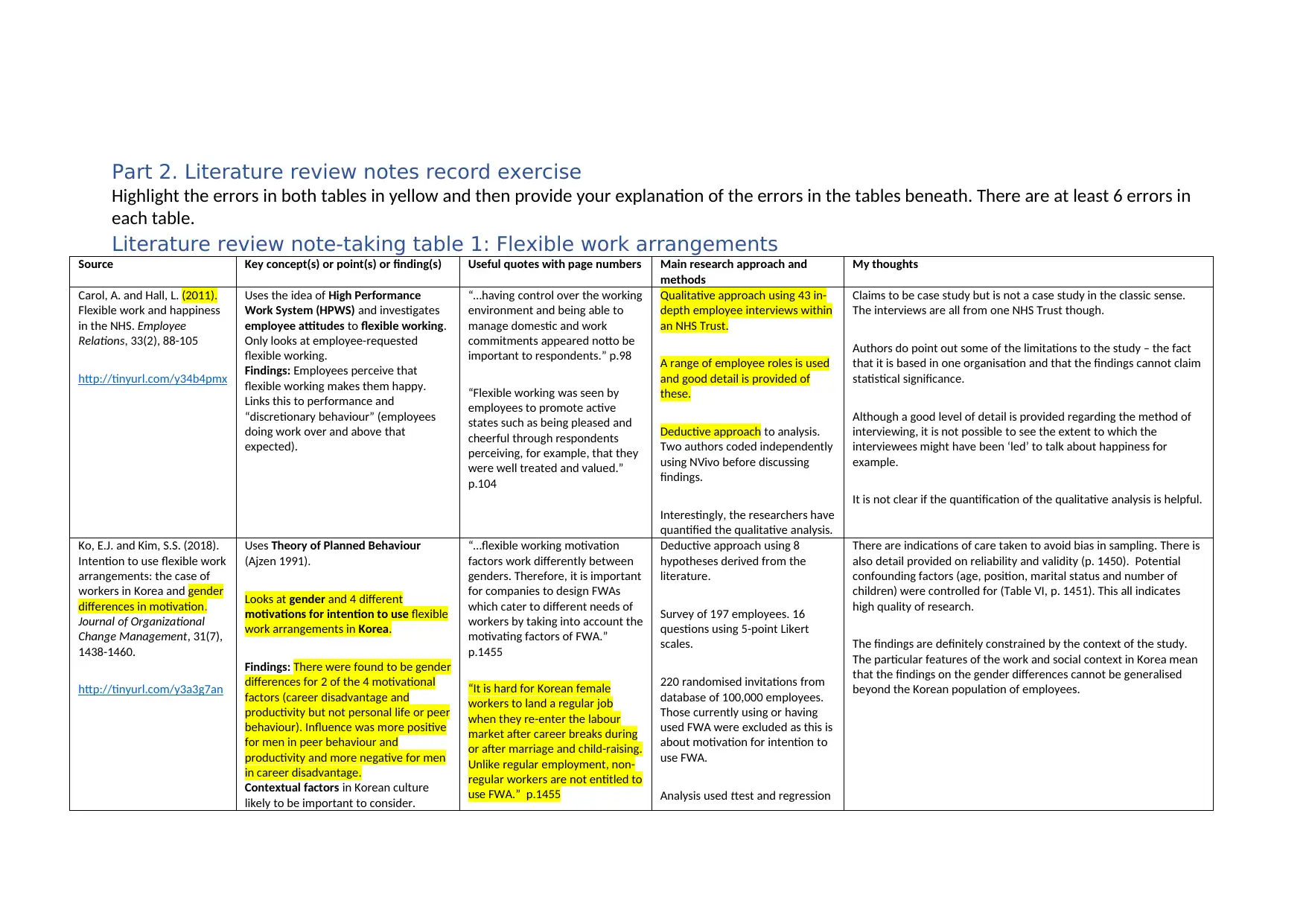
Part 2. Literature review notes record exercise
Highlight the errors in both tables in yellow and then provide your explanation of the errors in the tables beneath. There are at least 6 errors in
each table.
Literature review note-taking table 1: Flexible work arrangements
Source Key concept(s) or point(s) or finding(s) Useful quotes with page numbers Main research approach and
methods
My thoughts
Carol, A. and Hall, L. (2011).
Flexible work and happiness
in the NHS. Employee
Relations, 33(2), 88-105
http://tinyurl.com/y34b4pmx
Uses the idea of High Performance
Work System (HPWS) and investigates
employee attitudes to flexible working.
Only looks at employee-requested
flexible working.
Findings: Employees perceive that
flexible working makes them happy.
Links this to performance and
“discretionary behaviour” (employees
doing work over and above that
expected).
“…having control over the working
environment and being able to
manage domestic and work
commitments appeared notto be
important to respondents.” p.98
“Flexible working was seen by
employees to promote active
states such as being pleased and
cheerful through respondents
perceiving, for example, that they
were well treated and valued.”
p.104
Qualitative approach using 43 in-
depth employee interviews within
an NHS Trust.
A range of employee roles is used
and good detail is provided of
these.
Deductive approach to analysis.
Two authors coded independently
using NVivo before discussing
findings.
Interestingly, the researchers have
quantified the qualitative analysis.
Claims to be case study but is not a case study in the classic sense.
The interviews are all from one NHS Trust though.
Authors do point out some of the limitations to the study – the fact
that it is based in one organisation and that the findings cannot claim
statistical significance.
Although a good level of detail is provided regarding the method of
interviewing, it is not possible to see the extent to which the
interviewees might have been ‘led’ to talk about happiness for
example.
It is not clear if the quantification of the qualitative analysis is helpful.
Ko, E.J. and Kim, S.S. (2018).
Intention to use flexible work
arrangements: the case of
workers in Korea and gender
differences in motivation.
Journal of Organizational
Change Management, 31(7),
1438-1460.
http://tinyurl.com/y3a3g7an
Uses Theory of Planned Behaviour
(Ajzen 1991).
Looks at gender and 4 different
motivations for intention to use flexible
work arrangements in Korea.
Findings: There were found to be gender
differences for 2 of the 4 motivational
factors (career disadvantage and
productivity but not personal life or peer
behaviour). Influence was more positive
for men in peer behaviour and
productivity and more negative for men
in career disadvantage.
Contextual factors in Korean culture
likely to be important to consider.
“…flexible working motivation
factors work differently between
genders. Therefore, it is important
for companies to design FWAs
which cater to different needs of
workers by taking into account the
motivating factors of FWA.”
p.1455
“It is hard for Korean female
workers to land a regular job
when they re-enter the labour
market after career breaks during
or after marriage and child-raising.
Unlike regular employment, non-
regular workers are not entitled to
use FWA.” p.1455
Deductive approach using 8
hypotheses derived from the
literature.
Survey of 197 employees. 16
questions using 5-point Likert
scales.
220 randomised invitations from
database of 100,000 employees.
Those currently using or having
used FWA were excluded as this is
about motivation for intention to
use FWA.
Analysis used ttest and regression
There are indications of care taken to avoid bias in sampling. There is
also detail provided on reliability and validity (p. 1450). Potential
confounding factors (age, position, marital status and number of
children) were controlled for (Table VI, p. 1451). This all indicates
high quality of research.
The findings are definitely constrained by the context of the study.
The particular features of the work and social context in Korea mean
that the findings on the gender differences cannot be generalised
beyond the Korean population of employees.
Highlight the errors in both tables in yellow and then provide your explanation of the errors in the tables beneath. There are at least 6 errors in
each table.
Literature review note-taking table 1: Flexible work arrangements
Source Key concept(s) or point(s) or finding(s) Useful quotes with page numbers Main research approach and
methods
My thoughts
Carol, A. and Hall, L. (2011).
Flexible work and happiness
in the NHS. Employee
Relations, 33(2), 88-105
http://tinyurl.com/y34b4pmx
Uses the idea of High Performance
Work System (HPWS) and investigates
employee attitudes to flexible working.
Only looks at employee-requested
flexible working.
Findings: Employees perceive that
flexible working makes them happy.
Links this to performance and
“discretionary behaviour” (employees
doing work over and above that
expected).
“…having control over the working
environment and being able to
manage domestic and work
commitments appeared notto be
important to respondents.” p.98
“Flexible working was seen by
employees to promote active
states such as being pleased and
cheerful through respondents
perceiving, for example, that they
were well treated and valued.”
p.104
Qualitative approach using 43 in-
depth employee interviews within
an NHS Trust.
A range of employee roles is used
and good detail is provided of
these.
Deductive approach to analysis.
Two authors coded independently
using NVivo before discussing
findings.
Interestingly, the researchers have
quantified the qualitative analysis.
Claims to be case study but is not a case study in the classic sense.
The interviews are all from one NHS Trust though.
Authors do point out some of the limitations to the study – the fact
that it is based in one organisation and that the findings cannot claim
statistical significance.
Although a good level of detail is provided regarding the method of
interviewing, it is not possible to see the extent to which the
interviewees might have been ‘led’ to talk about happiness for
example.
It is not clear if the quantification of the qualitative analysis is helpful.
Ko, E.J. and Kim, S.S. (2018).
Intention to use flexible work
arrangements: the case of
workers in Korea and gender
differences in motivation.
Journal of Organizational
Change Management, 31(7),
1438-1460.
http://tinyurl.com/y3a3g7an
Uses Theory of Planned Behaviour
(Ajzen 1991).
Looks at gender and 4 different
motivations for intention to use flexible
work arrangements in Korea.
Findings: There were found to be gender
differences for 2 of the 4 motivational
factors (career disadvantage and
productivity but not personal life or peer
behaviour). Influence was more positive
for men in peer behaviour and
productivity and more negative for men
in career disadvantage.
Contextual factors in Korean culture
likely to be important to consider.
“…flexible working motivation
factors work differently between
genders. Therefore, it is important
for companies to design FWAs
which cater to different needs of
workers by taking into account the
motivating factors of FWA.”
p.1455
“It is hard for Korean female
workers to land a regular job
when they re-enter the labour
market after career breaks during
or after marriage and child-raising.
Unlike regular employment, non-
regular workers are not entitled to
use FWA.” p.1455
Deductive approach using 8
hypotheses derived from the
literature.
Survey of 197 employees. 16
questions using 5-point Likert
scales.
220 randomised invitations from
database of 100,000 employees.
Those currently using or having
used FWA were excluded as this is
about motivation for intention to
use FWA.
Analysis used ttest and regression
There are indications of care taken to avoid bias in sampling. There is
also detail provided on reliability and validity (p. 1450). Potential
confounding factors (age, position, marital status and number of
children) were controlled for (Table VI, p. 1451). This all indicates
high quality of research.
The findings are definitely constrained by the context of the study.
The particular features of the work and social context in Korea mean
that the findings on the gender differences cannot be generalised
beyond the Korean population of employees.
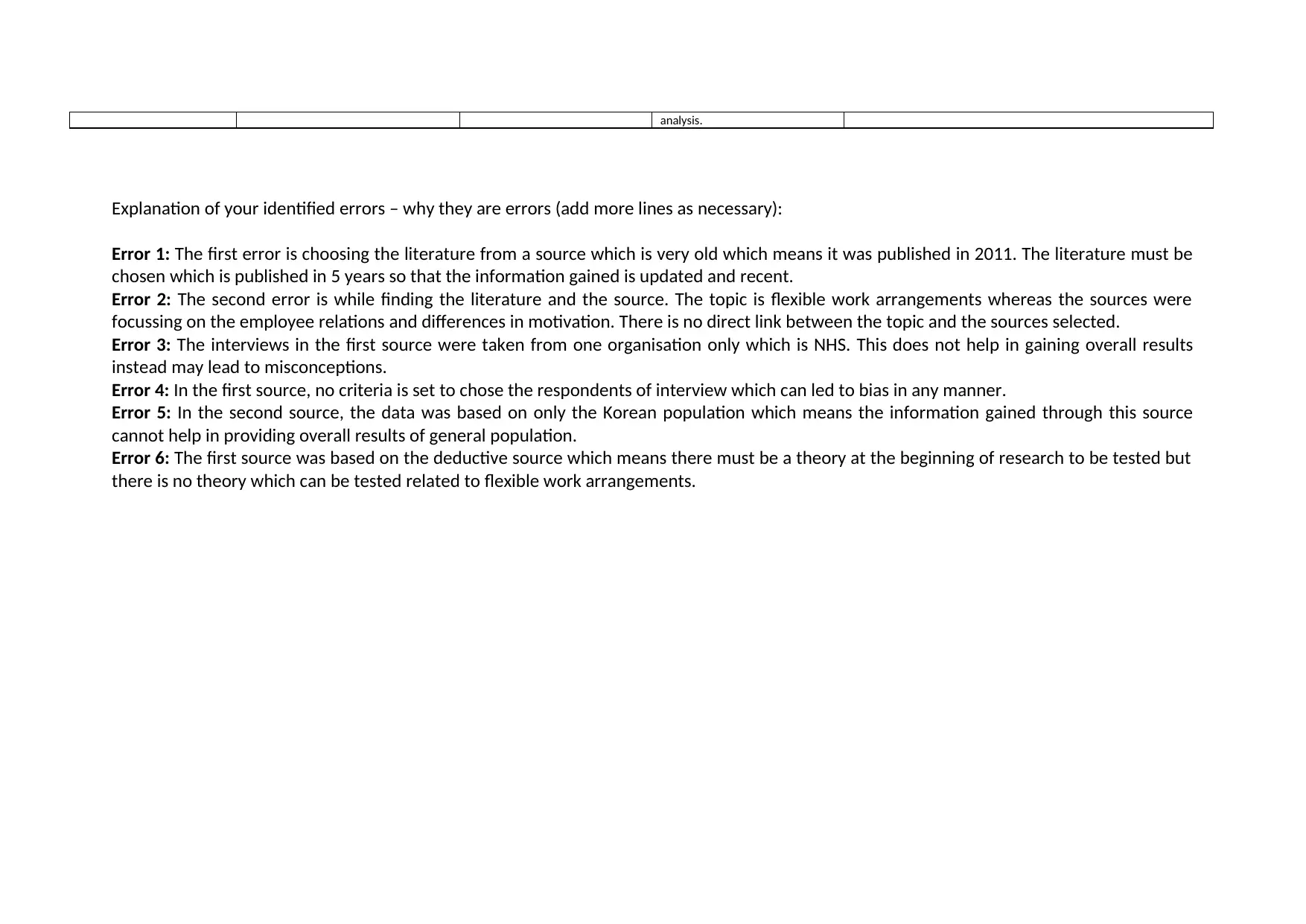
analysis.
Explanation of your identified errors – why they are errors (add more lines as necessary):
Error 1: The first error is choosing the literature from a source which is very old which means it was published in 2011. The literature must be
chosen which is published in 5 years so that the information gained is updated and recent.
Error 2: The second error is while finding the literature and the source. The topic is flexible work arrangements whereas the sources were
focussing on the employee relations and differences in motivation. There is no direct link between the topic and the sources selected.
Error 3: The interviews in the first source were taken from one organisation only which is NHS. This does not help in gaining overall results
instead may lead to misconceptions.
Error 4: In the first source, no criteria is set to chose the respondents of interview which can led to bias in any manner.
Error 5: In the second source, the data was based on only the Korean population which means the information gained through this source
cannot help in providing overall results of general population.
Error 6: The first source was based on the deductive source which means there must be a theory at the beginning of research to be tested but
there is no theory which can be tested related to flexible work arrangements.
Explanation of your identified errors – why they are errors (add more lines as necessary):
Error 1: The first error is choosing the literature from a source which is very old which means it was published in 2011. The literature must be
chosen which is published in 5 years so that the information gained is updated and recent.
Error 2: The second error is while finding the literature and the source. The topic is flexible work arrangements whereas the sources were
focussing on the employee relations and differences in motivation. There is no direct link between the topic and the sources selected.
Error 3: The interviews in the first source were taken from one organisation only which is NHS. This does not help in gaining overall results
instead may lead to misconceptions.
Error 4: In the first source, no criteria is set to chose the respondents of interview which can led to bias in any manner.
Error 5: In the second source, the data was based on only the Korean population which means the information gained through this source
cannot help in providing overall results of general population.
Error 6: The first source was based on the deductive source which means there must be a theory at the beginning of research to be tested but
there is no theory which can be tested related to flexible work arrangements.
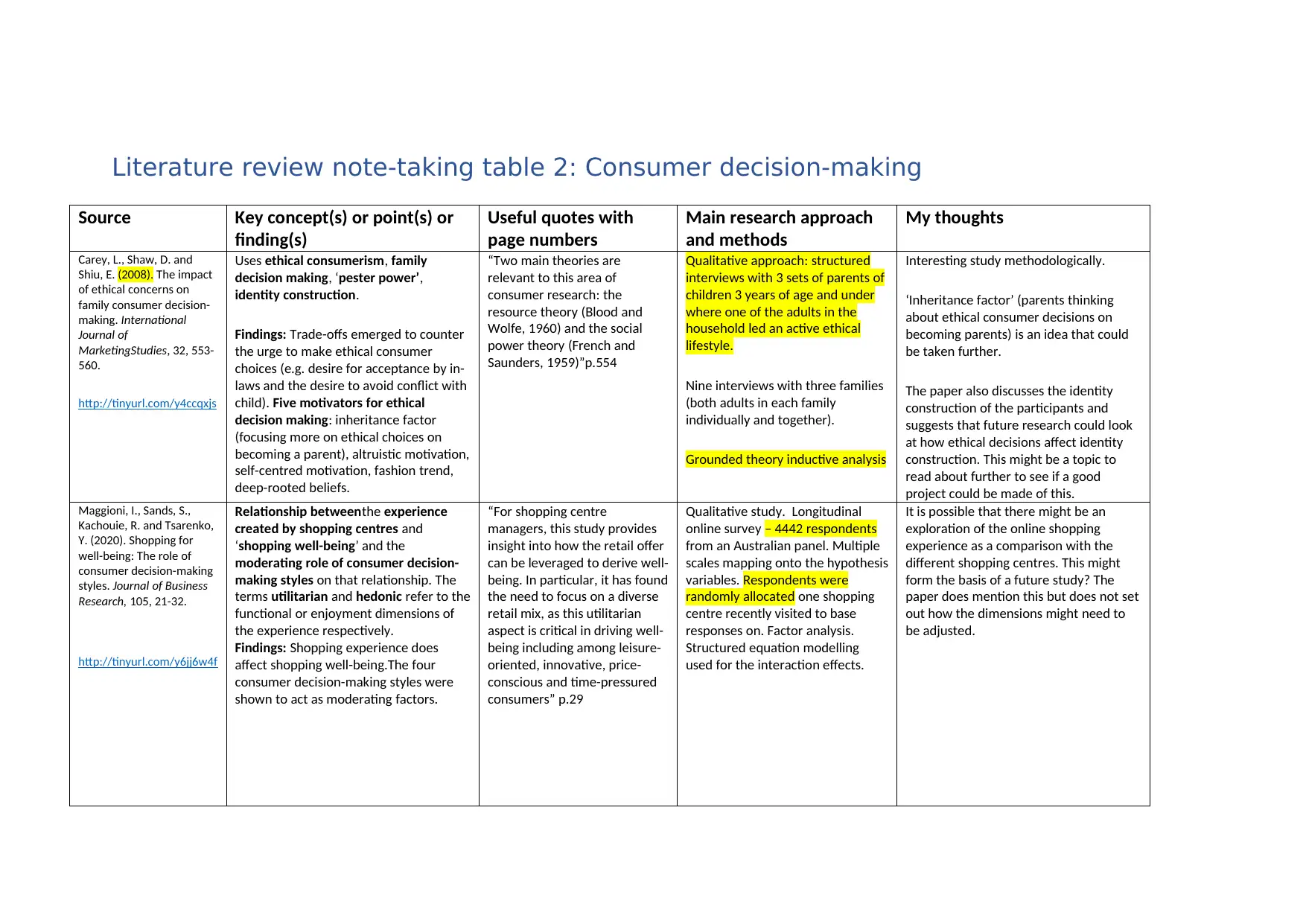
Literature review note-taking table 2: Consumer decision-making
Source Key concept(s) or point(s) or
finding(s)
Useful quotes with
page numbers
Main research approach
and methods
My thoughts
Carey, L., Shaw, D. and
Shiu, E. (2008). The impact
of ethical concerns on
family consumer decision-
making. International
Journal of
MarketingStudies, 32, 553-
560.
http://tinyurl.com/y4ccqxjs
Uses ethical consumerism, family
decision making, ‘pester power’,
identity construction.
Findings: Trade-offs emerged to counter
the urge to make ethical consumer
choices (e.g. desire for acceptance by in-
laws and the desire to avoid conflict with
child). Five motivators for ethical
decision making: inheritance factor
(focusing more on ethical choices on
becoming a parent), altruistic motivation,
self-centred motivation, fashion trend,
deep-rooted beliefs.
“Two main theories are
relevant to this area of
consumer research: the
resource theory (Blood and
Wolfe, 1960) and the social
power theory (French and
Saunders, 1959)”p.554
Qualitative approach: structured
interviews with 3 sets of parents of
children 3 years of age and under
where one of the adults in the
household led an active ethical
lifestyle.
Nine interviews with three families
(both adults in each family
individually and together).
Grounded theory inductive analysis
Interesting study methodologically.
‘Inheritance factor’ (parents thinking
about ethical consumer decisions on
becoming parents) is an idea that could
be taken further.
The paper also discusses the identity
construction of the participants and
suggests that future research could look
at how ethical decisions affect identity
construction. This might be a topic to
read about further to see if a good
project could be made of this.
Maggioni, I., Sands, S.,
Kachouie, R. and Tsarenko,
Y. (2020). Shopping for
well-being: The role of
consumer decision-making
styles. Journal of Business
Research, 105, 21-32.
http://tinyurl.com/y6jj6w4f
Relationship betweenthe experience
created by shopping centres and
‘shopping well-being’ and the
moderating role of consumer decision-
making styles on that relationship. The
terms utilitarian and hedonic refer to the
functional or enjoyment dimensions of
the experience respectively.
Findings: Shopping experience does
affect shopping well-being.The four
consumer decision-making styles were
shown to act as moderating factors.
“For shopping centre
managers, this study provides
insight into how the retail offer
can be leveraged to derive well-
being. In particular, it has found
the need to focus on a diverse
retail mix, as this utilitarian
aspect is critical in driving well-
being including among leisure-
oriented, innovative, price-
conscious and time-pressured
consumers” p.29
Qualitative study. Longitudinal
online survey – 4442 respondents
from an Australian panel. Multiple
scales mapping onto the hypothesis
variables. Respondents were
randomly allocated one shopping
centre recently visited to base
responses on. Factor analysis.
Structured equation modelling
used for the interaction effects.
It is possible that there might be an
exploration of the online shopping
experience as a comparison with the
different shopping centres. This might
form the basis of a future study? The
paper does mention this but does not set
out how the dimensions might need to
be adjusted.
Source Key concept(s) or point(s) or
finding(s)
Useful quotes with
page numbers
Main research approach
and methods
My thoughts
Carey, L., Shaw, D. and
Shiu, E. (2008). The impact
of ethical concerns on
family consumer decision-
making. International
Journal of
MarketingStudies, 32, 553-
560.
http://tinyurl.com/y4ccqxjs
Uses ethical consumerism, family
decision making, ‘pester power’,
identity construction.
Findings: Trade-offs emerged to counter
the urge to make ethical consumer
choices (e.g. desire for acceptance by in-
laws and the desire to avoid conflict with
child). Five motivators for ethical
decision making: inheritance factor
(focusing more on ethical choices on
becoming a parent), altruistic motivation,
self-centred motivation, fashion trend,
deep-rooted beliefs.
“Two main theories are
relevant to this area of
consumer research: the
resource theory (Blood and
Wolfe, 1960) and the social
power theory (French and
Saunders, 1959)”p.554
Qualitative approach: structured
interviews with 3 sets of parents of
children 3 years of age and under
where one of the adults in the
household led an active ethical
lifestyle.
Nine interviews with three families
(both adults in each family
individually and together).
Grounded theory inductive analysis
Interesting study methodologically.
‘Inheritance factor’ (parents thinking
about ethical consumer decisions on
becoming parents) is an idea that could
be taken further.
The paper also discusses the identity
construction of the participants and
suggests that future research could look
at how ethical decisions affect identity
construction. This might be a topic to
read about further to see if a good
project could be made of this.
Maggioni, I., Sands, S.,
Kachouie, R. and Tsarenko,
Y. (2020). Shopping for
well-being: The role of
consumer decision-making
styles. Journal of Business
Research, 105, 21-32.
http://tinyurl.com/y6jj6w4f
Relationship betweenthe experience
created by shopping centres and
‘shopping well-being’ and the
moderating role of consumer decision-
making styles on that relationship. The
terms utilitarian and hedonic refer to the
functional or enjoyment dimensions of
the experience respectively.
Findings: Shopping experience does
affect shopping well-being.The four
consumer decision-making styles were
shown to act as moderating factors.
“For shopping centre
managers, this study provides
insight into how the retail offer
can be leveraged to derive well-
being. In particular, it has found
the need to focus on a diverse
retail mix, as this utilitarian
aspect is critical in driving well-
being including among leisure-
oriented, innovative, price-
conscious and time-pressured
consumers” p.29
Qualitative study. Longitudinal
online survey – 4442 respondents
from an Australian panel. Multiple
scales mapping onto the hypothesis
variables. Respondents were
randomly allocated one shopping
centre recently visited to base
responses on. Factor analysis.
Structured equation modelling
used for the interaction effects.
It is possible that there might be an
exploration of the online shopping
experience as a comparison with the
different shopping centres. This might
form the basis of a future study? The
paper does mention this but does not set
out how the dimensions might need to
be adjusted.
Secure Best Marks with AI Grader
Need help grading? Try our AI Grader for instant feedback on your assignments.
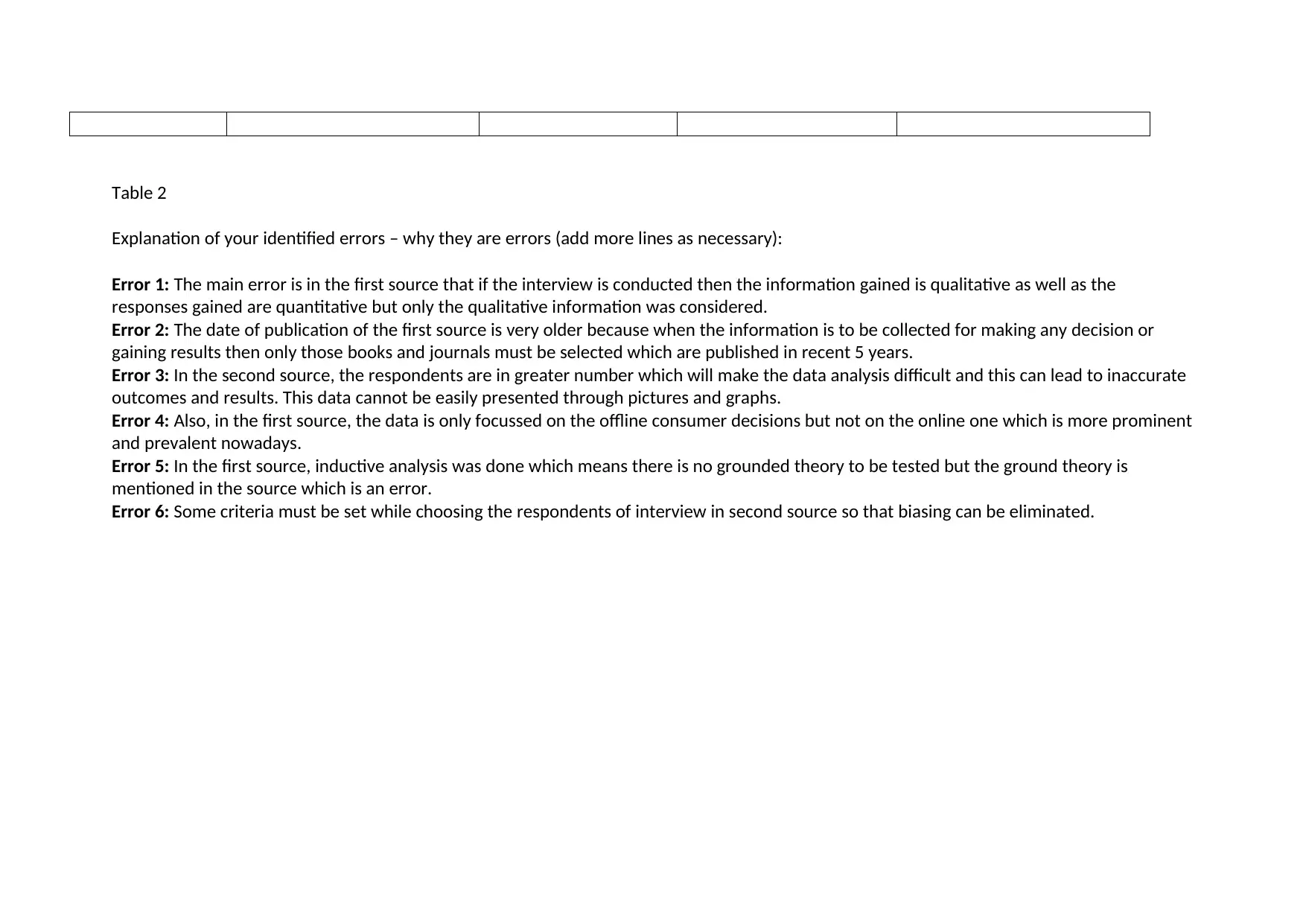
Table 2
Explanation of your identified errors – why they are errors (add more lines as necessary):
Error 1: The main error is in the first source that if the interview is conducted then the information gained is qualitative as well as the
responses gained are quantitative but only the qualitative information was considered.
Error 2: The date of publication of the first source is very older because when the information is to be collected for making any decision or
gaining results then only those books and journals must be selected which are published in recent 5 years.
Error 3: In the second source, the respondents are in greater number which will make the data analysis difficult and this can lead to inaccurate
outcomes and results. This data cannot be easily presented through pictures and graphs.
Error 4: Also, in the first source, the data is only focussed on the offline consumer decisions but not on the online one which is more prominent
and prevalent nowadays.
Error 5: In the first source, inductive analysis was done which means there is no grounded theory to be tested but the ground theory is
mentioned in the source which is an error.
Error 6: Some criteria must be set while choosing the respondents of interview in second source so that biasing can be eliminated.
Explanation of your identified errors – why they are errors (add more lines as necessary):
Error 1: The main error is in the first source that if the interview is conducted then the information gained is qualitative as well as the
responses gained are quantitative but only the qualitative information was considered.
Error 2: The date of publication of the first source is very older because when the information is to be collected for making any decision or
gaining results then only those books and journals must be selected which are published in recent 5 years.
Error 3: In the second source, the respondents are in greater number which will make the data analysis difficult and this can lead to inaccurate
outcomes and results. This data cannot be easily presented through pictures and graphs.
Error 4: Also, in the first source, the data is only focussed on the offline consumer decisions but not on the online one which is more prominent
and prevalent nowadays.
Error 5: In the first source, inductive analysis was done which means there is no grounded theory to be tested but the ground theory is
mentioned in the source which is an error.
Error 6: Some criteria must be set while choosing the respondents of interview in second source so that biasing can be eliminated.
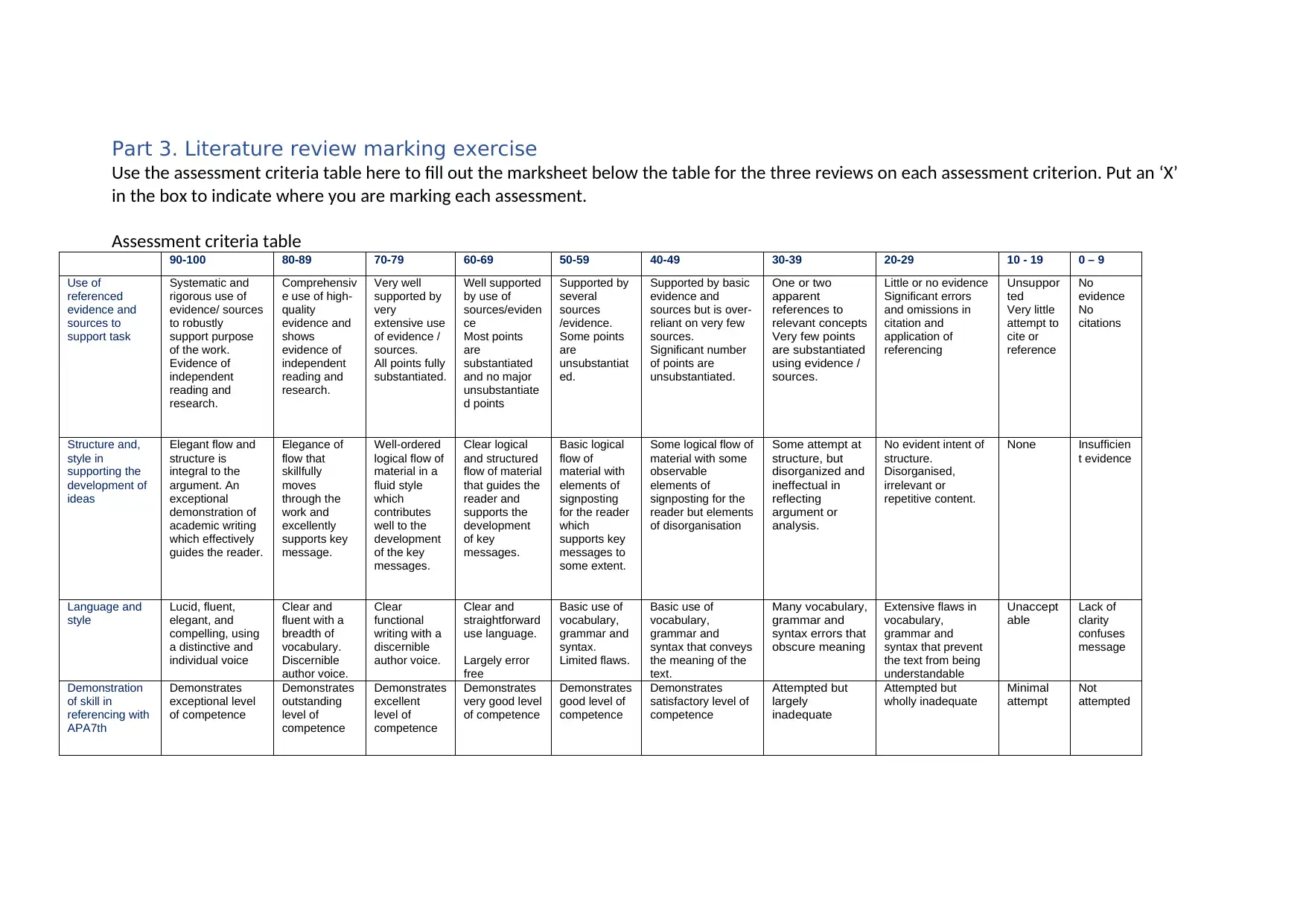
Part 3. Literature review marking exercise
Use the assessment criteria table here to fill out the marksheet below the table for the three reviews on each assessment criterion. Put an ‘X’
in the box to indicate where you are marking each assessment.
Assessment criteria table
90-100 80-89 70-79 60-69 50-59 40-49 30-39 20-29 10 - 19 0 – 9
Use of
referenced
evidence and
sources to
support task
Systematic and
rigorous use of
evidence/ sources
to robustly
support purpose
of the work.
Evidence of
independent
reading and
research.
Comprehensiv
e use of high-
quality
evidence and
shows
evidence of
independent
reading and
research.
Very well
supported by
very
extensive use
of evidence /
sources.
All points fully
substantiated.
Well supported
by use of
sources/eviden
ce
Most points
are
substantiated
and no major
unsubstantiate
d points
Supported by
several
sources
/evidence.
Some points
are
unsubstantiat
ed.
Supported by basic
evidence and
sources but is over-
reliant on very few
sources.
Significant number
of points are
unsubstantiated.
One or two
apparent
references to
relevant concepts
Very few points
are substantiated
using evidence /
sources.
Little or no evidence
Significant errors
and omissions in
citation and
application of
referencing
Unsuppor
ted
Very little
attempt to
cite or
reference
No
evidence
No
citations
Structure and,
style in
supporting the
development of
ideas
Elegant flow and
structure is
integral to the
argument. An
exceptional
demonstration of
academic writing
which effectively
guides the reader.
Elegance of
flow that
skillfully
moves
through the
work and
excellently
supports key
message.
Well-ordered
logical flow of
material in a
fluid style
which
contributes
well to the
development
of the key
messages.
Clear logical
and structured
flow of material
that guides the
reader and
supports the
development
of key
messages.
Basic logical
flow of
material with
elements of
signposting
for the reader
which
supports key
messages to
some extent.
Some logical flow of
material with some
observable
elements of
signposting for the
reader but elements
of disorganisation
Some attempt at
structure, but
disorganized and
ineffectual in
reflecting
argument or
analysis.
No evident intent of
structure.
Disorganised,
irrelevant or
repetitive content.
None Insufficien
t evidence
Language and
style
Lucid, fluent,
elegant, and
compelling, using
a distinctive and
individual voice
Clear and
fluent with a
breadth of
vocabulary.
Discernible
author voice.
Clear
functional
writing with a
discernible
author voice.
Clear and
straightforward
use language.
Largely error
free
Basic use of
vocabulary,
grammar and
syntax.
Limited flaws.
Basic use of
vocabulary,
grammar and
syntax that conveys
the meaning of the
text.
Many vocabulary,
grammar and
syntax errors that
obscure meaning
Extensive flaws in
vocabulary,
grammar and
syntax that prevent
the text from being
understandable
Unaccept
able
Lack of
clarity
confuses
message
Demonstration
of skill in
referencing with
APA7th
Demonstrates
exceptional level
of competence
Demonstrates
outstanding
level of
competence
Demonstrates
excellent
level of
competence
Demonstrates
very good level
of competence
Demonstrates
good level of
competence
Demonstrates
satisfactory level of
competence
Attempted but
largely
inadequate
Attempted but
wholly inadequate
Minimal
attempt
Not
attempted
Use the assessment criteria table here to fill out the marksheet below the table for the three reviews on each assessment criterion. Put an ‘X’
in the box to indicate where you are marking each assessment.
Assessment criteria table
90-100 80-89 70-79 60-69 50-59 40-49 30-39 20-29 10 - 19 0 – 9
Use of
referenced
evidence and
sources to
support task
Systematic and
rigorous use of
evidence/ sources
to robustly
support purpose
of the work.
Evidence of
independent
reading and
research.
Comprehensiv
e use of high-
quality
evidence and
shows
evidence of
independent
reading and
research.
Very well
supported by
very
extensive use
of evidence /
sources.
All points fully
substantiated.
Well supported
by use of
sources/eviden
ce
Most points
are
substantiated
and no major
unsubstantiate
d points
Supported by
several
sources
/evidence.
Some points
are
unsubstantiat
ed.
Supported by basic
evidence and
sources but is over-
reliant on very few
sources.
Significant number
of points are
unsubstantiated.
One or two
apparent
references to
relevant concepts
Very few points
are substantiated
using evidence /
sources.
Little or no evidence
Significant errors
and omissions in
citation and
application of
referencing
Unsuppor
ted
Very little
attempt to
cite or
reference
No
evidence
No
citations
Structure and,
style in
supporting the
development of
ideas
Elegant flow and
structure is
integral to the
argument. An
exceptional
demonstration of
academic writing
which effectively
guides the reader.
Elegance of
flow that
skillfully
moves
through the
work and
excellently
supports key
message.
Well-ordered
logical flow of
material in a
fluid style
which
contributes
well to the
development
of the key
messages.
Clear logical
and structured
flow of material
that guides the
reader and
supports the
development
of key
messages.
Basic logical
flow of
material with
elements of
signposting
for the reader
which
supports key
messages to
some extent.
Some logical flow of
material with some
observable
elements of
signposting for the
reader but elements
of disorganisation
Some attempt at
structure, but
disorganized and
ineffectual in
reflecting
argument or
analysis.
No evident intent of
structure.
Disorganised,
irrelevant or
repetitive content.
None Insufficien
t evidence
Language and
style
Lucid, fluent,
elegant, and
compelling, using
a distinctive and
individual voice
Clear and
fluent with a
breadth of
vocabulary.
Discernible
author voice.
Clear
functional
writing with a
discernible
author voice.
Clear and
straightforward
use language.
Largely error
free
Basic use of
vocabulary,
grammar and
syntax.
Limited flaws.
Basic use of
vocabulary,
grammar and
syntax that conveys
the meaning of the
text.
Many vocabulary,
grammar and
syntax errors that
obscure meaning
Extensive flaws in
vocabulary,
grammar and
syntax that prevent
the text from being
understandable
Unaccept
able
Lack of
clarity
confuses
message
Demonstration
of skill in
referencing with
APA7th
Demonstrates
exceptional level
of competence
Demonstrates
outstanding
level of
competence
Demonstrates
excellent
level of
competence
Demonstrates
very good level
of competence
Demonstrates
good level of
competence
Demonstrates
satisfactory level of
competence
Attempted but
largely
inadequate
Attempted but
wholly inadequate
Minimal
attempt
Not
attempted
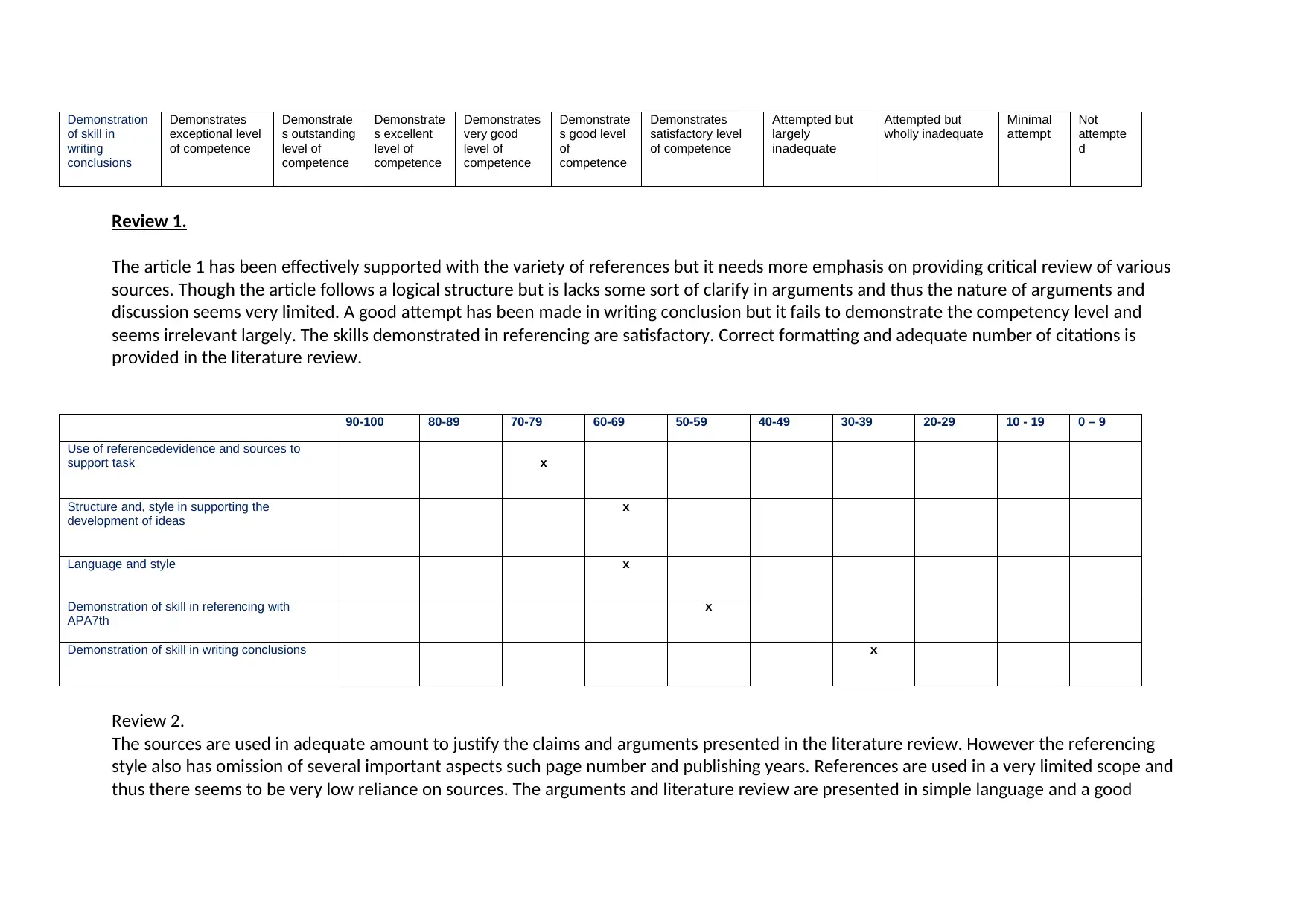
Demonstration
of skill in
writing
conclusions
Demonstrates
exceptional level
of competence
Demonstrate
s outstanding
level of
competence
Demonstrate
s excellent
level of
competence
Demonstrates
very good
level of
competence
Demonstrate
s good level
of
competence
Demonstrates
satisfactory level
of competence
Attempted but
largely
inadequate
Attempted but
wholly inadequate
Minimal
attempt
Not
attempte
d
Review 1.
The article 1 has been effectively supported with the variety of references but it needs more emphasis on providing critical review of various
sources. Though the article follows a logical structure but is lacks some sort of clarify in arguments and thus the nature of arguments and
discussion seems very limited. A good attempt has been made in writing conclusion but it fails to demonstrate the competency level and
seems irrelevant largely. The skills demonstrated in referencing are satisfactory. Correct formatting and adequate number of citations is
provided in the literature review.
90-100 80-89 70-79 60-69 50-59 40-49 30-39 20-29 10 - 19 0 – 9
Use of referencedevidence and sources to
support task x
Structure and, style in supporting the
development of ideas
x
Language and style x
Demonstration of skill in referencing with
APA7th
x
Demonstration of skill in writing conclusions x
Review 2.
The sources are used in adequate amount to justify the claims and arguments presented in the literature review. However the referencing
style also has omission of several important aspects such page number and publishing years. References are used in a very limited scope and
thus there seems to be very low reliance on sources. The arguments and literature review are presented in simple language and a good
of skill in
writing
conclusions
Demonstrates
exceptional level
of competence
Demonstrate
s outstanding
level of
competence
Demonstrate
s excellent
level of
competence
Demonstrates
very good
level of
competence
Demonstrate
s good level
of
competence
Demonstrates
satisfactory level
of competence
Attempted but
largely
inadequate
Attempted but
wholly inadequate
Minimal
attempt
Not
attempte
d
Review 1.
The article 1 has been effectively supported with the variety of references but it needs more emphasis on providing critical review of various
sources. Though the article follows a logical structure but is lacks some sort of clarify in arguments and thus the nature of arguments and
discussion seems very limited. A good attempt has been made in writing conclusion but it fails to demonstrate the competency level and
seems irrelevant largely. The skills demonstrated in referencing are satisfactory. Correct formatting and adequate number of citations is
provided in the literature review.
90-100 80-89 70-79 60-69 50-59 40-49 30-39 20-29 10 - 19 0 – 9
Use of referencedevidence and sources to
support task x
Structure and, style in supporting the
development of ideas
x
Language and style x
Demonstration of skill in referencing with
APA7th
x
Demonstration of skill in writing conclusions x
Review 2.
The sources are used in adequate amount to justify the claims and arguments presented in the literature review. However the referencing
style also has omission of several important aspects such page number and publishing years. References are used in a very limited scope and
thus there seems to be very low reliance on sources. The arguments and literature review are presented in simple language and a good
Paraphrase This Document
Need a fresh take? Get an instant paraphrase of this document with our AI Paraphraser
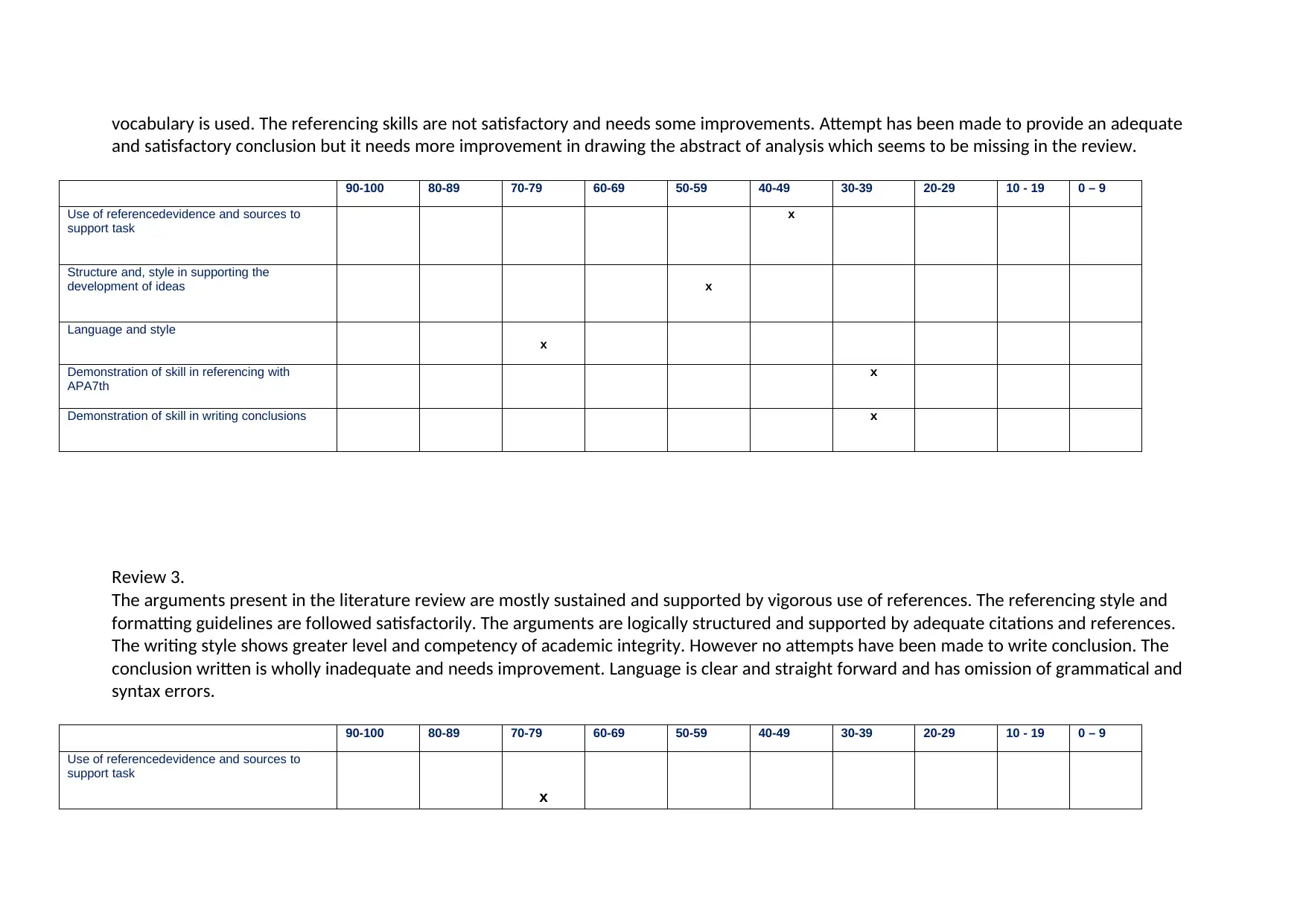
vocabulary is used. The referencing skills are not satisfactory and needs some improvements. Attempt has been made to provide an adequate
and satisfactory conclusion but it needs more improvement in drawing the abstract of analysis which seems to be missing in the review.
90-100 80-89 70-79 60-69 50-59 40-49 30-39 20-29 10 - 19 0 – 9
Use of referencedevidence and sources to
support task
x
Structure and, style in supporting the
development of ideas x
Language and style
x
Demonstration of skill in referencing with
APA7th
x
Demonstration of skill in writing conclusions x
Review 3.
The arguments present in the literature review are mostly sustained and supported by vigorous use of references. The referencing style and
formatting guidelines are followed satisfactorily. The arguments are logically structured and supported by adequate citations and references.
The writing style shows greater level and competency of academic integrity. However no attempts have been made to write conclusion. The
conclusion written is wholly inadequate and needs improvement. Language is clear and straight forward and has omission of grammatical and
syntax errors.
90-100 80-89 70-79 60-69 50-59 40-49 30-39 20-29 10 - 19 0 – 9
Use of referencedevidence and sources to
support task
x
and satisfactory conclusion but it needs more improvement in drawing the abstract of analysis which seems to be missing in the review.
90-100 80-89 70-79 60-69 50-59 40-49 30-39 20-29 10 - 19 0 – 9
Use of referencedevidence and sources to
support task
x
Structure and, style in supporting the
development of ideas x
Language and style
x
Demonstration of skill in referencing with
APA7th
x
Demonstration of skill in writing conclusions x
Review 3.
The arguments present in the literature review are mostly sustained and supported by vigorous use of references. The referencing style and
formatting guidelines are followed satisfactorily. The arguments are logically structured and supported by adequate citations and references.
The writing style shows greater level and competency of academic integrity. However no attempts have been made to write conclusion. The
conclusion written is wholly inadequate and needs improvement. Language is clear and straight forward and has omission of grammatical and
syntax errors.
90-100 80-89 70-79 60-69 50-59 40-49 30-39 20-29 10 - 19 0 – 9
Use of referencedevidence and sources to
support task
x
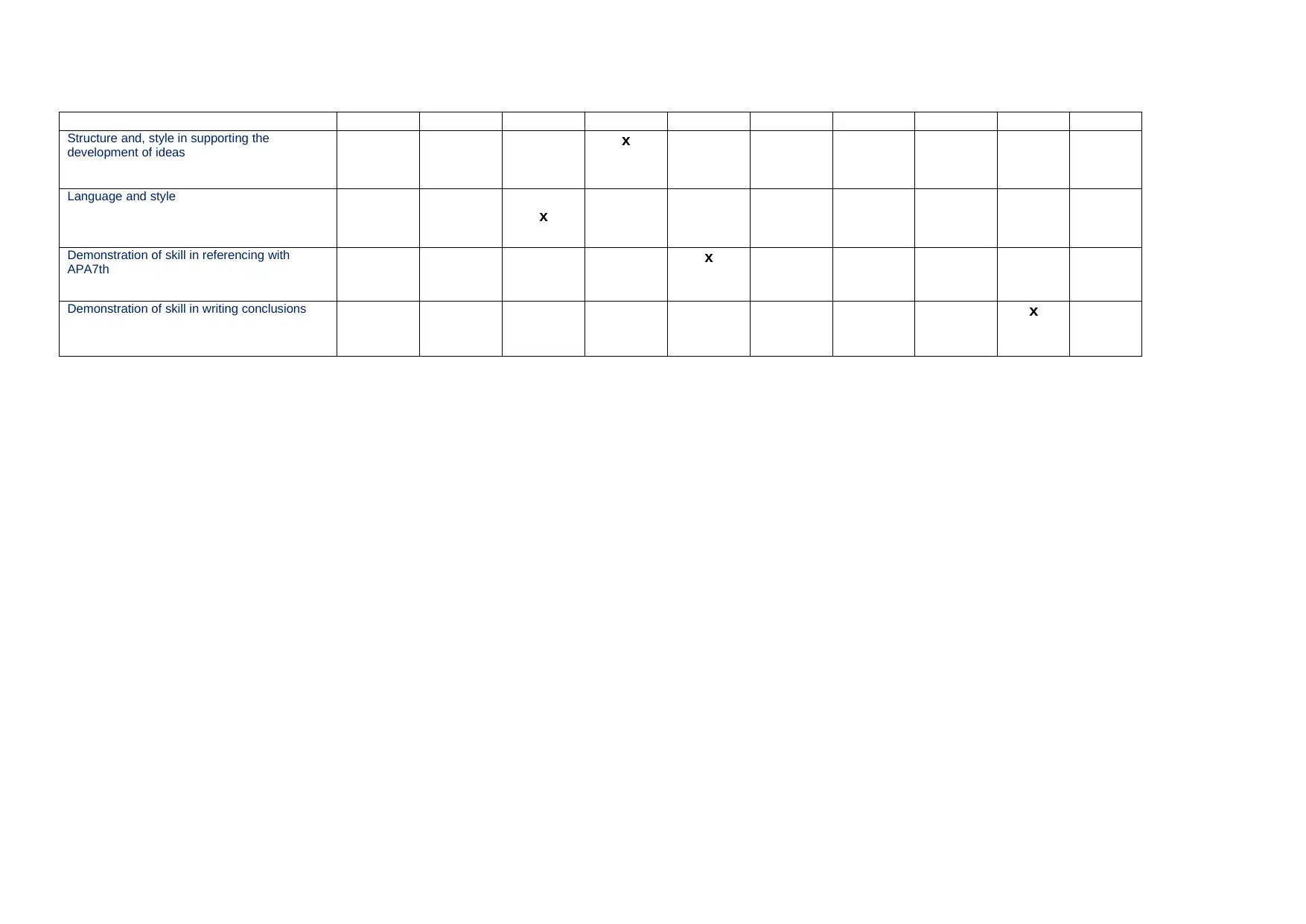
Structure and, style in supporting the
development of ideas x
Language and style
x
Demonstration of skill in referencing with
APA7th x
Demonstration of skill in writing conclusions x
development of ideas x
Language and style
x
Demonstration of skill in referencing with
APA7th x
Demonstration of skill in writing conclusions x
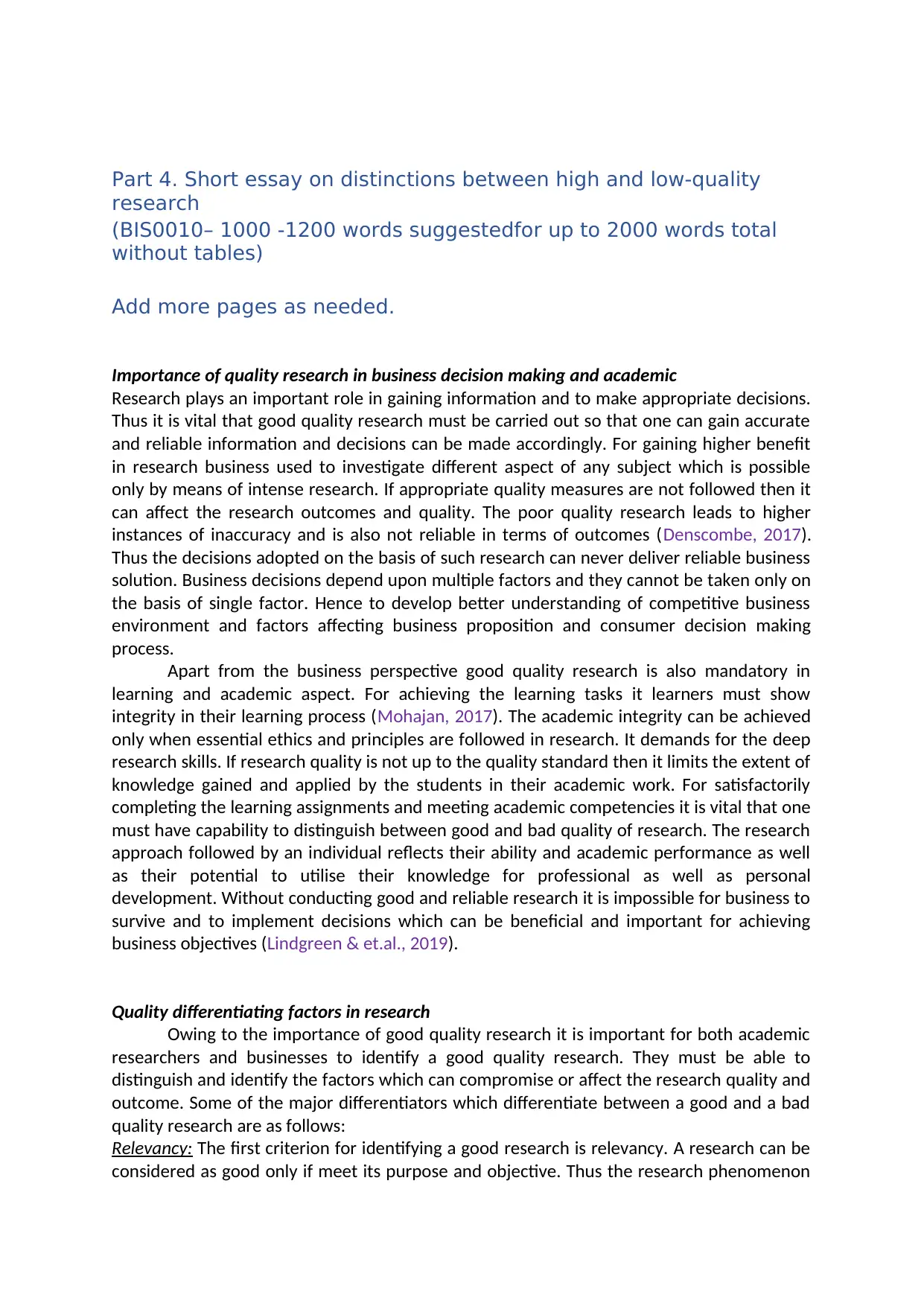
Part 4. Short essay on distinctions between high and low-quality
research
(BIS0010– 1000 -1200 words suggestedfor up to 2000 words total
without tables)
Add more pages as needed.
Importance of quality research in business decision making and academic
Research plays an important role in gaining information and to make appropriate decisions.
Thus it is vital that good quality research must be carried out so that one can gain accurate
and reliable information and decisions can be made accordingly. For gaining higher benefit
in research business used to investigate different aspect of any subject which is possible
only by means of intense research. If appropriate quality measures are not followed then it
can affect the research outcomes and quality. The poor quality research leads to higher
instances of inaccuracy and is also not reliable in terms of outcomes (Denscombe, 2017).
Thus the decisions adopted on the basis of such research can never deliver reliable business
solution. Business decisions depend upon multiple factors and they cannot be taken only on
the basis of single factor. Hence to develop better understanding of competitive business
environment and factors affecting business proposition and consumer decision making
process.
Apart from the business perspective good quality research is also mandatory in
learning and academic aspect. For achieving the learning tasks it learners must show
integrity in their learning process (Mohajan, 2017). The academic integrity can be achieved
only when essential ethics and principles are followed in research. It demands for the deep
research skills. If research quality is not up to the quality standard then it limits the extent of
knowledge gained and applied by the students in their academic work. For satisfactorily
completing the learning assignments and meeting academic competencies it is vital that one
must have capability to distinguish between good and bad quality of research. The research
approach followed by an individual reflects their ability and academic performance as well
as their potential to utilise their knowledge for professional as well as personal
development. Without conducting good and reliable research it is impossible for business to
survive and to implement decisions which can be beneficial and important for achieving
business objectives (Lindgreen & et.al., 2019).
Quality differentiating factors in research
Owing to the importance of good quality research it is important for both academic
researchers and businesses to identify a good quality research. They must be able to
distinguish and identify the factors which can compromise or affect the research quality and
outcome. Some of the major differentiators which differentiate between a good and a bad
quality research are as follows:
Relevancy: The first criterion for identifying a good research is relevancy. A research can be
considered as good only if meet its purpose and objective. Thus the research phenomenon
research
(BIS0010– 1000 -1200 words suggestedfor up to 2000 words total
without tables)
Add more pages as needed.
Importance of quality research in business decision making and academic
Research plays an important role in gaining information and to make appropriate decisions.
Thus it is vital that good quality research must be carried out so that one can gain accurate
and reliable information and decisions can be made accordingly. For gaining higher benefit
in research business used to investigate different aspect of any subject which is possible
only by means of intense research. If appropriate quality measures are not followed then it
can affect the research outcomes and quality. The poor quality research leads to higher
instances of inaccuracy and is also not reliable in terms of outcomes (Denscombe, 2017).
Thus the decisions adopted on the basis of such research can never deliver reliable business
solution. Business decisions depend upon multiple factors and they cannot be taken only on
the basis of single factor. Hence to develop better understanding of competitive business
environment and factors affecting business proposition and consumer decision making
process.
Apart from the business perspective good quality research is also mandatory in
learning and academic aspect. For achieving the learning tasks it learners must show
integrity in their learning process (Mohajan, 2017). The academic integrity can be achieved
only when essential ethics and principles are followed in research. It demands for the deep
research skills. If research quality is not up to the quality standard then it limits the extent of
knowledge gained and applied by the students in their academic work. For satisfactorily
completing the learning assignments and meeting academic competencies it is vital that one
must have capability to distinguish between good and bad quality of research. The research
approach followed by an individual reflects their ability and academic performance as well
as their potential to utilise their knowledge for professional as well as personal
development. Without conducting good and reliable research it is impossible for business to
survive and to implement decisions which can be beneficial and important for achieving
business objectives (Lindgreen & et.al., 2019).
Quality differentiating factors in research
Owing to the importance of good quality research it is important for both academic
researchers and businesses to identify a good quality research. They must be able to
distinguish and identify the factors which can compromise or affect the research quality and
outcome. Some of the major differentiators which differentiate between a good and a bad
quality research are as follows:
Relevancy: The first criterion for identifying a good research is relevancy. A research can be
considered as good only if meet its purpose and objective. Thus the research phenomenon
Secure Best Marks with AI Grader
Need help grading? Try our AI Grader for instant feedback on your assignments.
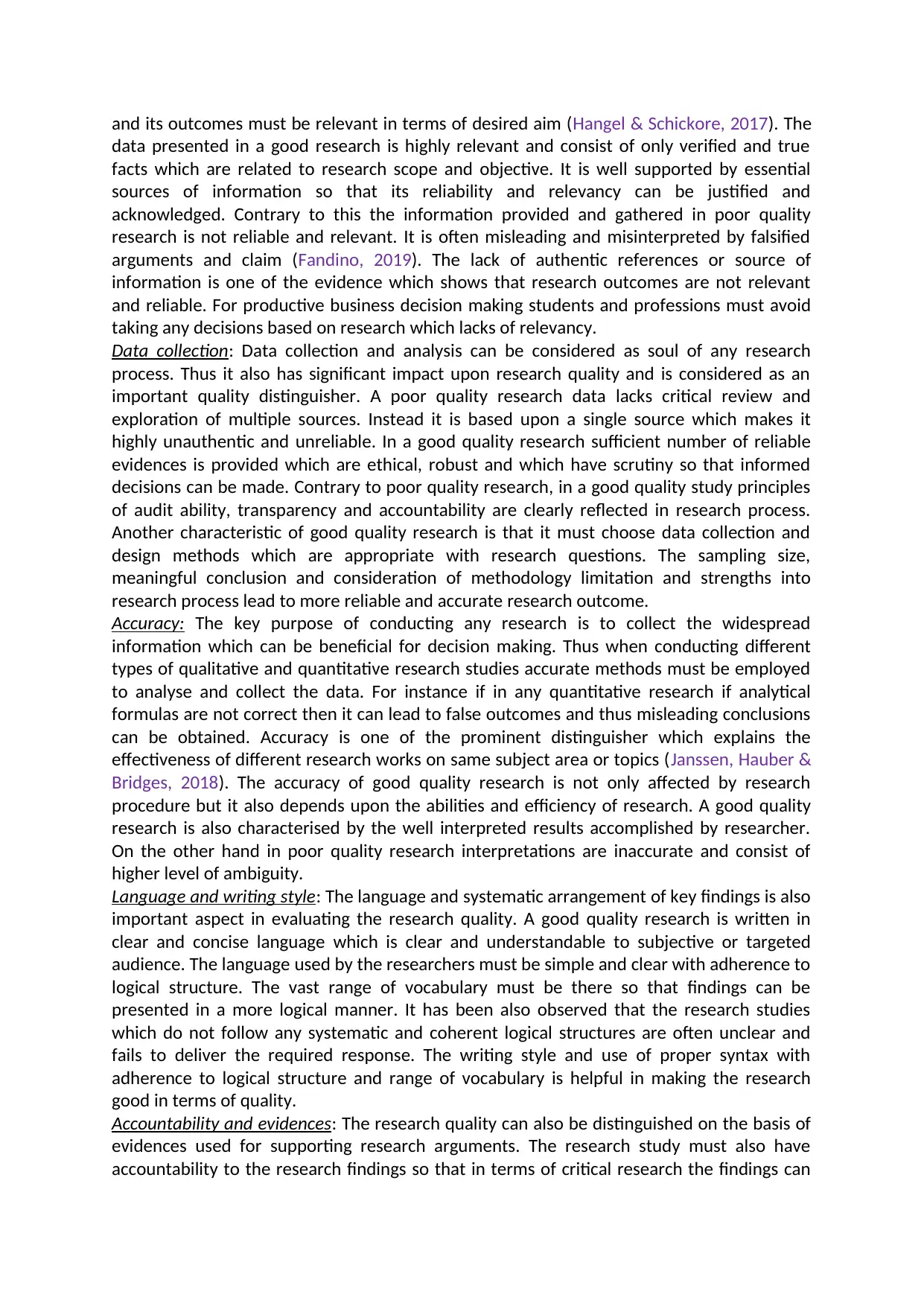
and its outcomes must be relevant in terms of desired aim (Hangel & Schickore, 2017). The
data presented in a good research is highly relevant and consist of only verified and true
facts which are related to research scope and objective. It is well supported by essential
sources of information so that its reliability and relevancy can be justified and
acknowledged. Contrary to this the information provided and gathered in poor quality
research is not reliable and relevant. It is often misleading and misinterpreted by falsified
arguments and claim (Fandino, 2019). The lack of authentic references or source of
information is one of the evidence which shows that research outcomes are not relevant
and reliable. For productive business decision making students and professions must avoid
taking any decisions based on research which lacks of relevancy.
Data collection: Data collection and analysis can be considered as soul of any research
process. Thus it also has significant impact upon research quality and is considered as an
important quality distinguisher. A poor quality research data lacks critical review and
exploration of multiple sources. Instead it is based upon a single source which makes it
highly unauthentic and unreliable. In a good quality research sufficient number of reliable
evidences is provided which are ethical, robust and which have scrutiny so that informed
decisions can be made. Contrary to poor quality research, in a good quality study principles
of audit ability, transparency and accountability are clearly reflected in research process.
Another characteristic of good quality research is that it must choose data collection and
design methods which are appropriate with research questions. The sampling size,
meaningful conclusion and consideration of methodology limitation and strengths into
research process lead to more reliable and accurate research outcome.
Accuracy: The key purpose of conducting any research is to collect the widespread
information which can be beneficial for decision making. Thus when conducting different
types of qualitative and quantitative research studies accurate methods must be employed
to analyse and collect the data. For instance if in any quantitative research if analytical
formulas are not correct then it can lead to false outcomes and thus misleading conclusions
can be obtained. Accuracy is one of the prominent distinguisher which explains the
effectiveness of different research works on same subject area or topics (Janssen, Hauber &
Bridges, 2018). The accuracy of good quality research is not only affected by research
procedure but it also depends upon the abilities and efficiency of research. A good quality
research is also characterised by the well interpreted results accomplished by researcher.
On the other hand in poor quality research interpretations are inaccurate and consist of
higher level of ambiguity.
Language and writing style: The language and systematic arrangement of key findings is also
important aspect in evaluating the research quality. A good quality research is written in
clear and concise language which is clear and understandable to subjective or targeted
audience. The language used by the researchers must be simple and clear with adherence to
logical structure. The vast range of vocabulary must be there so that findings can be
presented in a more logical manner. It has been also observed that the research studies
which do not follow any systematic and coherent logical structures are often unclear and
fails to deliver the required response. The writing style and use of proper syntax with
adherence to logical structure and range of vocabulary is helpful in making the research
good in terms of quality.
Accountability and evidences: The research quality can also be distinguished on the basis of
evidences used for supporting research arguments. The research study must also have
accountability to the research findings so that in terms of critical research the findings can
data presented in a good research is highly relevant and consist of only verified and true
facts which are related to research scope and objective. It is well supported by essential
sources of information so that its reliability and relevancy can be justified and
acknowledged. Contrary to this the information provided and gathered in poor quality
research is not reliable and relevant. It is often misleading and misinterpreted by falsified
arguments and claim (Fandino, 2019). The lack of authentic references or source of
information is one of the evidence which shows that research outcomes are not relevant
and reliable. For productive business decision making students and professions must avoid
taking any decisions based on research which lacks of relevancy.
Data collection: Data collection and analysis can be considered as soul of any research
process. Thus it also has significant impact upon research quality and is considered as an
important quality distinguisher. A poor quality research data lacks critical review and
exploration of multiple sources. Instead it is based upon a single source which makes it
highly unauthentic and unreliable. In a good quality research sufficient number of reliable
evidences is provided which are ethical, robust and which have scrutiny so that informed
decisions can be made. Contrary to poor quality research, in a good quality study principles
of audit ability, transparency and accountability are clearly reflected in research process.
Another characteristic of good quality research is that it must choose data collection and
design methods which are appropriate with research questions. The sampling size,
meaningful conclusion and consideration of methodology limitation and strengths into
research process lead to more reliable and accurate research outcome.
Accuracy: The key purpose of conducting any research is to collect the widespread
information which can be beneficial for decision making. Thus when conducting different
types of qualitative and quantitative research studies accurate methods must be employed
to analyse and collect the data. For instance if in any quantitative research if analytical
formulas are not correct then it can lead to false outcomes and thus misleading conclusions
can be obtained. Accuracy is one of the prominent distinguisher which explains the
effectiveness of different research works on same subject area or topics (Janssen, Hauber &
Bridges, 2018). The accuracy of good quality research is not only affected by research
procedure but it also depends upon the abilities and efficiency of research. A good quality
research is also characterised by the well interpreted results accomplished by researcher.
On the other hand in poor quality research interpretations are inaccurate and consist of
higher level of ambiguity.
Language and writing style: The language and systematic arrangement of key findings is also
important aspect in evaluating the research quality. A good quality research is written in
clear and concise language which is clear and understandable to subjective or targeted
audience. The language used by the researchers must be simple and clear with adherence to
logical structure. The vast range of vocabulary must be there so that findings can be
presented in a more logical manner. It has been also observed that the research studies
which do not follow any systematic and coherent logical structures are often unclear and
fails to deliver the required response. The writing style and use of proper syntax with
adherence to logical structure and range of vocabulary is helpful in making the research
good in terms of quality.
Accountability and evidences: The research quality can also be distinguished on the basis of
evidences used for supporting research arguments. The research study must also have
accountability to the research findings so that in terms of critical research the findings can
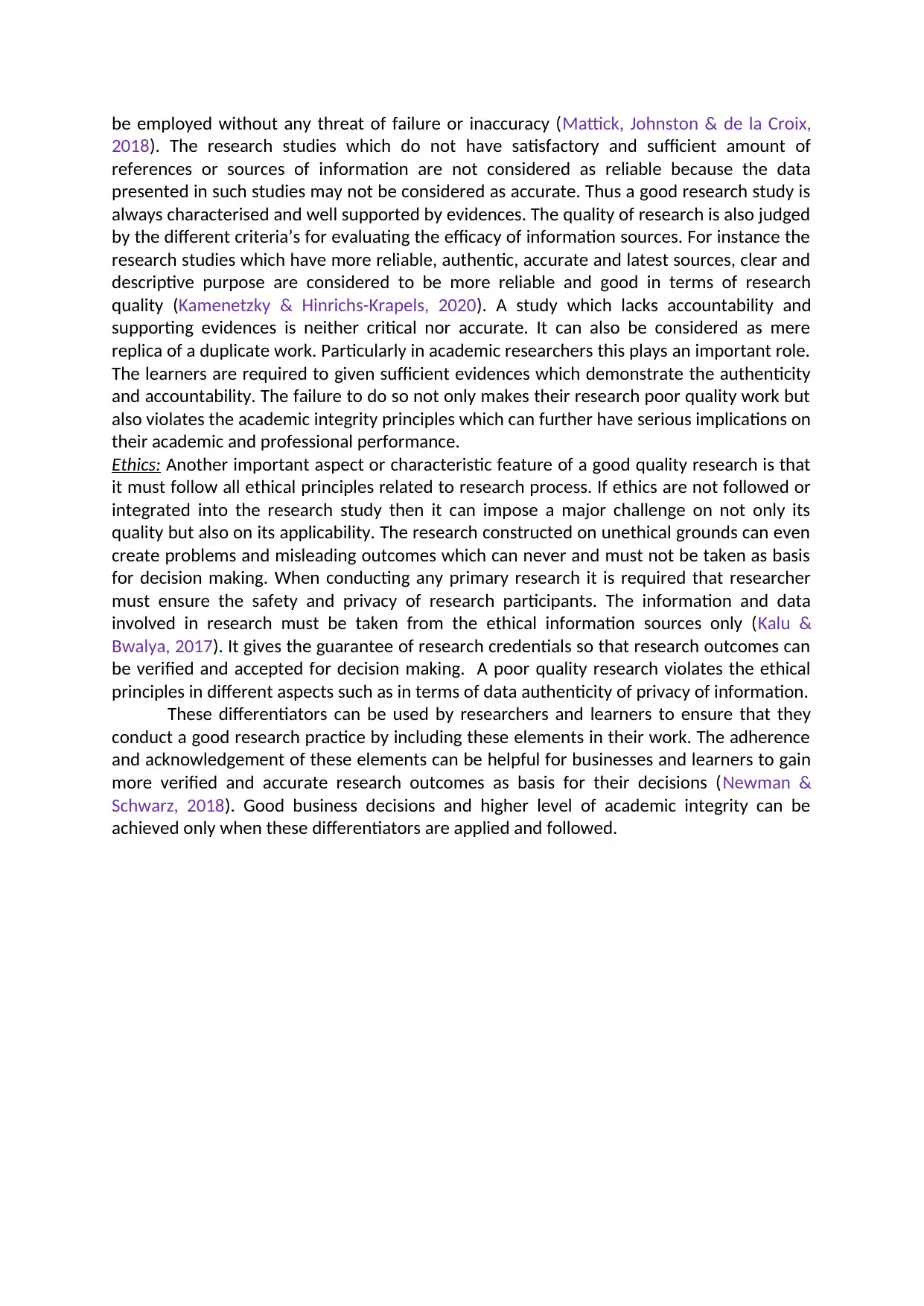
be employed without any threat of failure or inaccuracy (Mattick, Johnston & de la Croix,
2018). The research studies which do not have satisfactory and sufficient amount of
references or sources of information are not considered as reliable because the data
presented in such studies may not be considered as accurate. Thus a good research study is
always characterised and well supported by evidences. The quality of research is also judged
by the different criteria’s for evaluating the efficacy of information sources. For instance the
research studies which have more reliable, authentic, accurate and latest sources, clear and
descriptive purpose are considered to be more reliable and good in terms of research
quality (Kamenetzky & Hinrichs-Krapels, 2020). A study which lacks accountability and
supporting evidences is neither critical nor accurate. It can also be considered as mere
replica of a duplicate work. Particularly in academic researchers this plays an important role.
The learners are required to given sufficient evidences which demonstrate the authenticity
and accountability. The failure to do so not only makes their research poor quality work but
also violates the academic integrity principles which can further have serious implications on
their academic and professional performance.
Ethics: Another important aspect or characteristic feature of a good quality research is that
it must follow all ethical principles related to research process. If ethics are not followed or
integrated into the research study then it can impose a major challenge on not only its
quality but also on its applicability. The research constructed on unethical grounds can even
create problems and misleading outcomes which can never and must not be taken as basis
for decision making. When conducting any primary research it is required that researcher
must ensure the safety and privacy of research participants. The information and data
involved in research must be taken from the ethical information sources only (Kalu &
Bwalya, 2017). It gives the guarantee of research credentials so that research outcomes can
be verified and accepted for decision making. A poor quality research violates the ethical
principles in different aspects such as in terms of data authenticity of privacy of information.
These differentiators can be used by researchers and learners to ensure that they
conduct a good research practice by including these elements in their work. The adherence
and acknowledgement of these elements can be helpful for businesses and learners to gain
more verified and accurate research outcomes as basis for their decisions (Newman &
Schwarz, 2018). Good business decisions and higher level of academic integrity can be
achieved only when these differentiators are applied and followed.
2018). The research studies which do not have satisfactory and sufficient amount of
references or sources of information are not considered as reliable because the data
presented in such studies may not be considered as accurate. Thus a good research study is
always characterised and well supported by evidences. The quality of research is also judged
by the different criteria’s for evaluating the efficacy of information sources. For instance the
research studies which have more reliable, authentic, accurate and latest sources, clear and
descriptive purpose are considered to be more reliable and good in terms of research
quality (Kamenetzky & Hinrichs-Krapels, 2020). A study which lacks accountability and
supporting evidences is neither critical nor accurate. It can also be considered as mere
replica of a duplicate work. Particularly in academic researchers this plays an important role.
The learners are required to given sufficient evidences which demonstrate the authenticity
and accountability. The failure to do so not only makes their research poor quality work but
also violates the academic integrity principles which can further have serious implications on
their academic and professional performance.
Ethics: Another important aspect or characteristic feature of a good quality research is that
it must follow all ethical principles related to research process. If ethics are not followed or
integrated into the research study then it can impose a major challenge on not only its
quality but also on its applicability. The research constructed on unethical grounds can even
create problems and misleading outcomes which can never and must not be taken as basis
for decision making. When conducting any primary research it is required that researcher
must ensure the safety and privacy of research participants. The information and data
involved in research must be taken from the ethical information sources only (Kalu &
Bwalya, 2017). It gives the guarantee of research credentials so that research outcomes can
be verified and accepted for decision making. A poor quality research violates the ethical
principles in different aspects such as in terms of data authenticity of privacy of information.
These differentiators can be used by researchers and learners to ensure that they
conduct a good research practice by including these elements in their work. The adherence
and acknowledgement of these elements can be helpful for businesses and learners to gain
more verified and accurate research outcomes as basis for their decisions (Newman &
Schwarz, 2018). Good business decisions and higher level of academic integrity can be
achieved only when these differentiators are applied and followed.
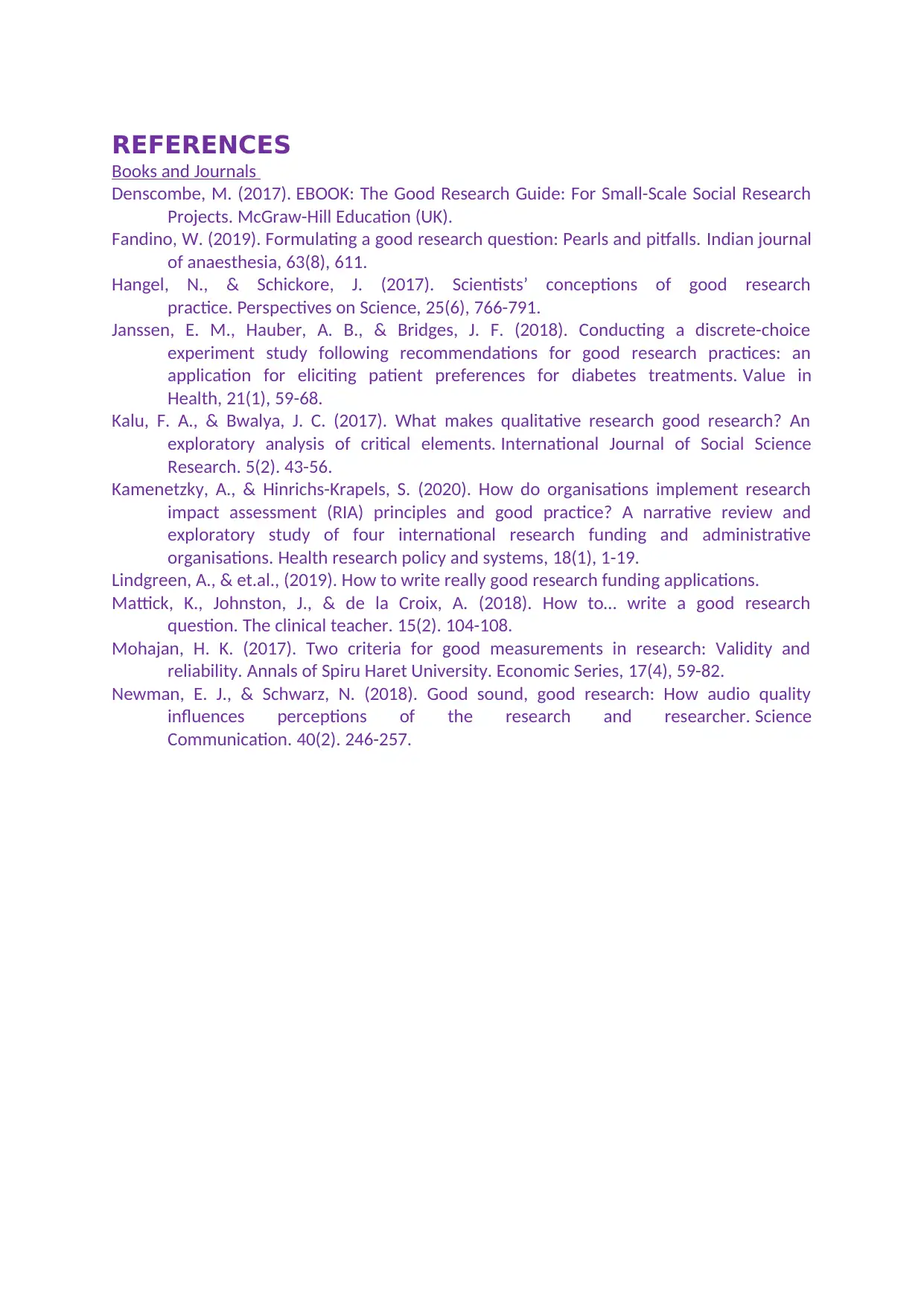
REFERENCES
Books and Journals
Denscombe, M. (2017). EBOOK: The Good Research Guide: For Small-Scale Social Research
Projects. McGraw-Hill Education (UK).
Fandino, W. (2019). Formulating a good research question: Pearls and pitfalls. Indian journal
of anaesthesia, 63(8), 611.
Hangel, N., & Schickore, J. (2017). Scientists’ conceptions of good research
practice. Perspectives on Science, 25(6), 766-791.
Janssen, E. M., Hauber, A. B., & Bridges, J. F. (2018). Conducting a discrete-choice
experiment study following recommendations for good research practices: an
application for eliciting patient preferences for diabetes treatments. Value in
Health, 21(1), 59-68.
Kalu, F. A., & Bwalya, J. C. (2017). What makes qualitative research good research? An
exploratory analysis of critical elements. International Journal of Social Science
Research. 5(2). 43-56.
Kamenetzky, A., & Hinrichs-Krapels, S. (2020). How do organisations implement research
impact assessment (RIA) principles and good practice? A narrative review and
exploratory study of four international research funding and administrative
organisations. Health research policy and systems, 18(1), 1-19.
Lindgreen, A., & et.al., (2019). How to write really good research funding applications.
Mattick, K., Johnston, J., & de la Croix, A. (2018). How to… write a good research
question. The clinical teacher. 15(2). 104-108.
Mohajan, H. K. (2017). Two criteria for good measurements in research: Validity and
reliability. Annals of Spiru Haret University. Economic Series, 17(4), 59-82.
Newman, E. J., & Schwarz, N. (2018). Good sound, good research: How audio quality
influences perceptions of the research and researcher. Science
Communication. 40(2). 246-257.
Books and Journals
Denscombe, M. (2017). EBOOK: The Good Research Guide: For Small-Scale Social Research
Projects. McGraw-Hill Education (UK).
Fandino, W. (2019). Formulating a good research question: Pearls and pitfalls. Indian journal
of anaesthesia, 63(8), 611.
Hangel, N., & Schickore, J. (2017). Scientists’ conceptions of good research
practice. Perspectives on Science, 25(6), 766-791.
Janssen, E. M., Hauber, A. B., & Bridges, J. F. (2018). Conducting a discrete-choice
experiment study following recommendations for good research practices: an
application for eliciting patient preferences for diabetes treatments. Value in
Health, 21(1), 59-68.
Kalu, F. A., & Bwalya, J. C. (2017). What makes qualitative research good research? An
exploratory analysis of critical elements. International Journal of Social Science
Research. 5(2). 43-56.
Kamenetzky, A., & Hinrichs-Krapels, S. (2020). How do organisations implement research
impact assessment (RIA) principles and good practice? A narrative review and
exploratory study of four international research funding and administrative
organisations. Health research policy and systems, 18(1), 1-19.
Lindgreen, A., & et.al., (2019). How to write really good research funding applications.
Mattick, K., Johnston, J., & de la Croix, A. (2018). How to… write a good research
question. The clinical teacher. 15(2). 104-108.
Mohajan, H. K. (2017). Two criteria for good measurements in research: Validity and
reliability. Annals of Spiru Haret University. Economic Series, 17(4), 59-82.
Newman, E. J., & Schwarz, N. (2018). Good sound, good research: How audio quality
influences perceptions of the research and researcher. Science
Communication. 40(2). 246-257.
1 out of 13
Your All-in-One AI-Powered Toolkit for Academic Success.
+13062052269
info@desklib.com
Available 24*7 on WhatsApp / Email
![[object Object]](/_next/static/media/star-bottom.7253800d.svg)
Unlock your academic potential
© 2024 | Zucol Services PVT LTD | All rights reserved.


